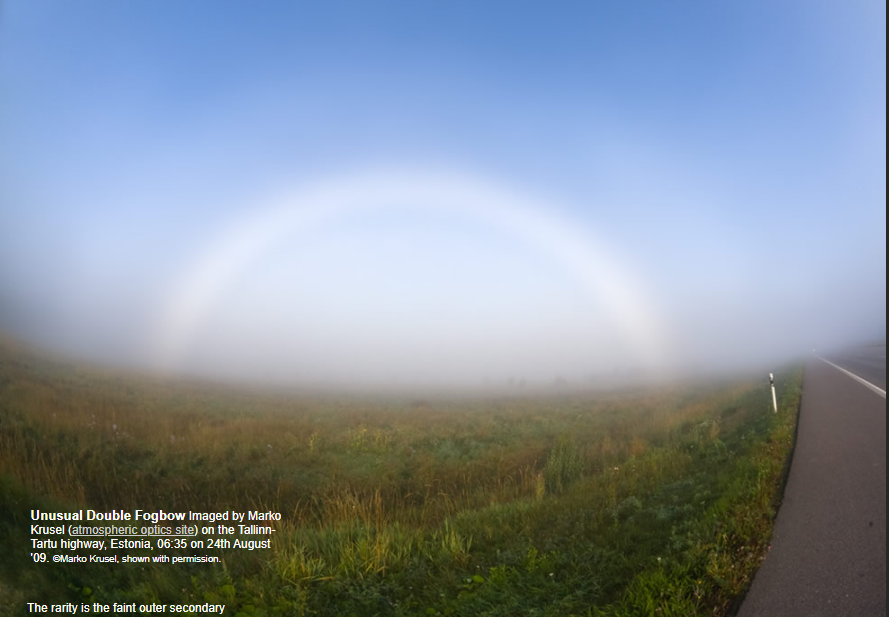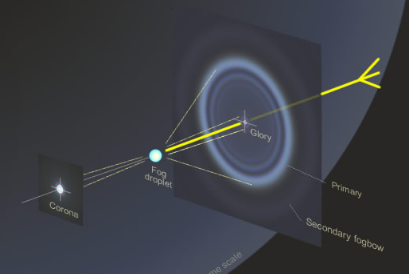Fogbow
The Enigmatic Beauty of Fogbows
Fogbows, also known as white rainbows or cloudbows, are a mesmerizing atmospheric phenomenon that captures the imagination of those fortunate enough to witness them. These ethereal spectacles resemble faint, colorless rainbows, creating an aura of mystery and intrigue. While they may appear similar to their vibrant and colorful counterparts, fogbows possess unique characteristics that set them apart. In this article, we will delve into the captivating world of fogbows, exploring their formation, distinctive features, and the science behind their enchanting appearance.
Unveiling the Ephemeral Emanations
Unlike traditional rainbows, which occur in the presence of raindrops, fogbows materialize in the presence of tiny water droplets suspended in fog or mist. These delicate droplets act as miniature prisms, refracting sunlight and creating a faint glow in the sky. The formation of a fogbow is a result of light waves being reflected and refracted within these minuscule droplets, producing a captivating display of diffused light.
The Elusive Secondary Fogbow
One of the most remarkable aspects of fogbows is the occasional presence of a secondary bow surrounding the primary one. This outer bow is an exceptionally rare occurrence, as secondaries are rarely seen or photographed in naturally lit fogbows. However, they become more apparent in night fogbows produced by bright lamps. The secondary fogbow arises from light waves reflecting twice within the fog droplets, intensifying the ethereal beauty of these atmospheric phenomena.
Decoding the Colors
Upon observing a fogbow, one may notice its predominantly colorless appearance. Unlike rainbows, which exhibit a vibrant array of hues, fogbows often lack such vivid pigmentation. However, careful examination may reveal a slight red outer edge on the inner primary fogbow. This subtle coloring provides valuable insight into the size of the fog droplets responsible for the fogbow's creation. The presence of a faint red hue indicates that the fog droplets were relatively small in size.
A Glimpse into Droplet Diversity
Within the primary fogbow, a characteristically dark band can be observed. Unlike traditional rainbows, which often display distinct supernumerary bands, fogbows lack such clearly defined features. This absence suggests that the fog droplets encompassed a range of sizes, contributing to the enigmatic appearance of the primary fogbow. The diverse dimensions of these droplets create a captivating interplay of light and shadow within the atmospheric phenomenon.
The Age of Fog and Droplet Evolution
The formation of fog is a complex process influenced by various factors, including temperature, humidity, and radiative cooling. Morning fog, which has formed during the night through radiative cooling of the Earth and lower layers of the atmosphere, is often referred to as "old fog." In contrast to freshly formed fog, "old fog" contains a diverse range of droplet sizes. This disparity arises from collisions between droplets and the preferential evaporation of smaller droplets, which subsequently condense onto larger ones. The presence of "old fog" droplets contributes to the intriguing nature of fogbows, allowing for a captivating interplay of light and droplet size variation.
The Allure of Fogbows: A Delicate Dance with Nature
Fogbows exemplify the intricate dance between light and water vapor, captivating our senses with their delicate beauty. These ethereal phenomena serve as a reminder of the wondrous intricacies that exist within our atmosphere. As we gaze upon these elusive spectacles, we are reminded of the ever-present mysteries that nature conceals, inviting us to explore and appreciate the enigmatic wonders that surround us.
Conclusion
Fogbows are a captivating atmospheric optics phenomenon that holds a unique place in our understanding of light and water vapor interactions. Their colorless appearance, the occasional presence of a secondary bow, and the absence of clear supernumeraries contribute to their ethereal beauty. The diverse range of droplet sizes within fogbows, influenced by the age of the fog and droplet evolution, adds to their enigmatic nature. As we marvel at the delicate dance between light and fog droplets, let us embrace the allure of fogbows and continue to explore the captivating wonders that grace our atmosphere.

Unusual Double Fogbow Imaged by Marko Krusel (atmospheric optics site) on the Tallinn-Tartu highway, Estonia, 06:35 on 24th August '09. ©Marko Krusel, shown with permission.
The rarity is the faint outer secondary fogbow from light waves reflected twice within the fog droplets. Secondaries are rarely seen let alone photographed in naturally lit fogbows although they are obvious in night fogbows produced by bright lamps.
The bright inner primary fogbow has little colour, just a slight red outer edge. That tells us that the fog droplets were small.
There is a characteristically dark band inside the primary but no clear supernumeraries - the droplets therefore had a range of sizes.
Morning fog that has formed in the night from radiative cooling of the earth and lower air layers tends to be 'old'. 'Old fog' as opposed to the freshly formed variety has a range of drop sizes, the result of collisions and preferential evaporation of small drops to feed condensation on larger ones. Fresh fog droplets have not had time to evolve.

Note: this article has been automatically converted from the old site and may not appear as intended. You can find the original article here.
Reference Atmospheric Optics
If you use any of the definitions, information, or data presented on Atmospheric Optics, please copy the link or reference below to properly credit us as the reference source. Thank you!
-
<a href="https://atoptics.co.uk/blog/fogbow-4/">Fogbow</a>
-
"Fogbow". Atmospheric Optics. Accessed on November 28, 2024. https://atoptics.co.uk/blog/fogbow-4/.
-
"Fogbow". Atmospheric Optics, https://atoptics.co.uk/blog/fogbow-4/. Accessed 28 November, 2024
-
Fogbow. Atmospheric Optics. Retrieved from https://atoptics.co.uk/blog/fogbow-4/.